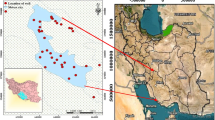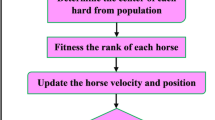Abstract
Infiltration is an important hydrological process affecting the runoff, groundwater recharge and solute transport process. The Green–Ampt (GA) model, describing one-dimensional infiltration process, yields an implicit equation for estimation of cumulative infiltration with time. In this paper, an explicit approximation to the GA model is derived using two-step curve-fitting technique. The Marquardt’s algorithm is employed for least-squares estimation of nonlinear parameters. Performance of the proposed model is compared with the implicit GA model using numerical and published field experimental data. The quantitative statistical indicators namely, percent relative error (RE), maximum absolute percent relative error (MARE), percent bias (PB), and Nash–Sutcliffe modeling efficiency (E), are used to assess the performance of the proposed model. The solution of the proposed model matched very well with that of the implicit GA model with MARE ≤ 0.146%, PB ≤ 0.070%, and E value approximately equal to 1 for both the dimensionless numerical and dimensional field experimental infiltration estimates. Simulation results of the proposed model demonstrated the capability of the derived model in estimating infiltration rate and cumulative infiltration accurately and can be applied to solve variety of real-life hydrological problems.






Similar content being viewed by others
References
Al-Azawi SA (1985) Experimental evaluation of infiltration models. J Hydrol 24(2):77–87
Ali S, Ghosh NC, Singh R, Sethy BK (2013) Generalized explicit models for estimation of wetting front length and potential recharge. Water Resour Manag 27:2429–2445
Ali S, Islam A, Mishra PK, Sikka AK (2016) Green–Ampt approximations: a comprehensive analysis. J Hydrol 535:340–355
Almedeij J, Esen II (2014) Modified Green–Ampt infiltration model for steady rainfall. J Hydrol Eng 19(9):04014011
Arnold JG, Srinivasan R, Muttiah RS, William JR (1998) Large area hydrologic modelling and assessment. Part 1: model development. J Am Water Resour Assoc 34(1):73–89
Barry DA, Parlange JY, Sander GC, Sivapalan M (1995) Comment on explicit expression for Green–Ampt (delta function diffusivity) infiltration rate and cumulative storage. Water Resour Res 31(5):1445–1446
Barry DA, Parlange JY, Li L, Jeng DS, Crapper M (2005) Green–Ampt approximations. Adv Water Resour 28:1003–1009
Beasley D, Huggins L (1982) Answers: Areal nonpoint source watershed environment simulation. User’s Manual, Report No. EPA-905/9-82-001. USEPA, Chicago
Bouwer H (1969) Infiltration of water into nonuniform soil. J Irrig Drain Div 95(IR4):451–462
Brakensiek DL (1977) Estimating the effective capillary pressure in the Green and Ampt infiltration equation. Water Resour Res 13(3):680–682
Brooks RH, Corey AT (1964) Hydraulic properties of porous media. Hydrology Paper 3. Colorado State University Fort Collins
Enciso-Medina J, Martin D, Eisenhauer D (1998) Infiltration model from furrow irrigation. J Irrig Drain Eng 124(2):73–80
Gowdish L, Munoz-Carpena R (2009) An improved Green–Ampt infiltration redistribution method for uneven multi storm series. Vadose Zone J 8(2):470–479
Green WH, Ampt G (1911) Study in soil Physics. I. The flow of air and water through soils. J Agric Sci 4:1–24
Horton RI (1938) The interpretation and application of runoff plot experiments with reference to soil erosion problems. Soil Sci Soc Am Proc 3:340–349
Kale RV, Sahoo B (2011) Green–Ampt infiltration models for varied field conditions: a Revisit. Water Resour Manag 25:3505–3536
Kostiakov AH (1932) On the dynamics of the coefficient of water percolation in soils and on the necessity of studying it from a dynamic point of view for purpose of amelioration. In: Transactions 6th congress of the international society of soil science, Moscow, Russia, Part A, pp 7–21
Lane IJ, Nearing MA (1989) USDA-Water erosion prediction project: hillslope profile model documentation. NSERI, Report No. 2. West Lafayette., Ind.: USDA-ARS National Soil Erosion Research Laboratory
Li RM, Steven MA, Simons DB (1976) Solutions to Green–Ampt infiltration equation. J Irrig Drain Div ASCE 102(IR2):239–248
Loáiciga H, Huang A (2007) Ponding analysis with Green-and-Ampt Infiltration. J Hydrol Eng 12(1):109–112
Marquardt DW (1963) An algorithm for least squares estimation of nonlinear parameters. J Soc Ind Appl Math 11(2):431–441
Michel C (2005) Discussion of improved decomposition solution to Green and Ampt infiltration equation by Serrano S E, (2003). J Hydrol Eng ASCE 10(5):434–435
Mishra SK, Tyagi JV, Singh VP (2003) Comparison of infiltration models. Hydrol Process 17:2629–2652
Morel-Seytoux HJ, Khanji J (1974) Derivation of an equation of infiltration. Water Resour Res 10(4):795–800
Nash JE, Sutcliffe JV (1970) River flow forecasting through conceptual model. Part 1-A discussion of principles. J Hydrol 10:282–290
Neuman SP (1976) Wetting front pressure head in the infiltration model of Green and Ampt. Water Resour Res 12(3):564–566
Parhi PK, Mishra SK, Singh R (2007) A modification to Kostiakov and modified Kostiakov infiltration model. Water Resour Manag 21:1973–1989
Parlange JY, Lisle I, Braddock RD, Smith RE (1982) The three-parameter in infiltration equation. Soil Sci 133(6):337–341
Parlange JY, Barry DA, Haverkamp R (2002) Explicit infiltration equations and the Lambert W-function. Adv Water Resour 25:1119–1124
Philip JR (1957) The theory of infiltration, 1. The infiltration equation and its solution. Soil Sci 83:345–357
Rao MD, Raghuwanshi NS, Singh R (2006) Development of a physically based 1D-infiltration model for seal formed irrigated soils. Agric Water Manag 84(1–2):164–174
Rathie PN, Swamee PK, Cavalcante ALB, de SM Ozelim LC (2012) Lagrange’s inversion theorem and infiltration. World Acad Sci Eng Technol 67:473–478
Rawls WJ, Brakensiek DL, Saxon KE (1982) Estimation of soil water properties. Trans Am Soc Agric Eng 25:1316–1320
Richards LA (1931) Capillary conduction of liquids through porous media. J Appl Phys 5:313–318
Salvucci GD, Entekhabi D (1994) Explicit expressions for Green–Ampt (delta function diffusivity) infiltration rate and cumulative storage. Water Resour Res 30(9):2661–2663
Serrano SE (2003) Improved decomposition solution to Green and Ampt infiltration equation. J Hydrol Eng ASCE 8(3):158–160
Singh VP, Yu FX (1990) Derivation of infiltration equation using systems approach. J Irrig Drain Eng 116(6):837–858
Sorman AU, Abdulrazzak MJ, Ugas MAS (1995). Application of infiltration models to field data from Wadi Tabalah, Saudi Arabia. In: Proc Viena Symp, IAHS Publ. No. 212
Stone JJ, Hawkins RH, Shirley ED (1994) Approximate form of Green–Ampt infiltration equation. J Irrig Drain Eng 102(1):128–137
Swamee PK, Rathie PN, de SM Ozelim LC (2012) Explicit equations for infiltration. J Hydrol 426–427:151–153
Swamee PK, Rathie PN, de SM Ozelim LC, Cavalcante ALB (2014) Recent advance on solving the three-parameter infiltration equation. J Hydrol 509:188–192
Swartzendruber D (1974) Infiltration of constant flux rainfall into soils: analysed by the Green and Ampt. Soil Sci 117:272–283
Swartzendruber D, Clague FR (1989) An inclusive infiltration equation for downward water entry into soil. Water Resour Res 25(4):619–626
SYSTAT (2006) SigmaPlot user guide, Release 10.0 edition. Systat Software Inc, Sanjose
Taormina R, Chau KW (2015) Neural network river forecasting with multi-objective fully informed particle swarm optimization. J Hydroinform 17(1):99–113
Van Liew MW, Veith TL, Bosch DD, Arnold JG (2007) Suitability of SWAT for the conservation effects assessment project: comparison on USDA agricultural research service watersheds. J Hydrol Eng ASCE 12(2):173–189
Varado N, Braud I, Ross PJ, Haverkamp R (2006) Assessment of an efficient numerical solution of the 1D Richards’ equation on bare soil. J Hydrol 323:244–257
Vatankhah AR (2015) Discussion of modified Green–Ampt infiltration model for steady rainfall by J Almedeij and I I Esen. J Hydrol Eng ASCE 20(4):07014011
Author information
Authors and Affiliations
Corresponding author
Rights and permissions
About this article
Cite this article
Ali, S., Islam, A. Solution to Green–Ampt infiltration model using a two-step curve-fitting approach. Environ Earth Sci 77, 271 (2018). https://doi.org/10.1007/s12665-018-7449-8
Received:
Accepted:
Published:
DOI: https://doi.org/10.1007/s12665-018-7449-8




